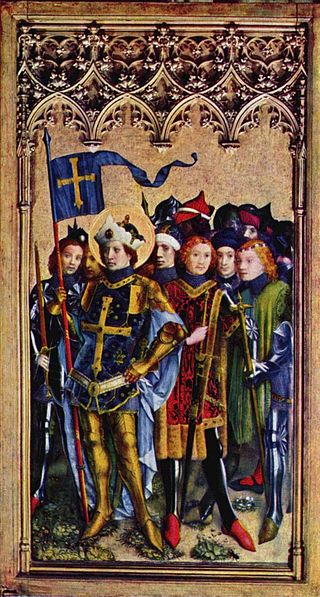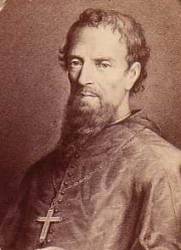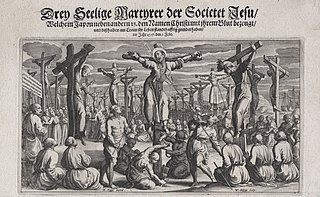See also
- Roman Martyrology, the official martyrology of the Roman Catholic Church
This page is an index of lists of people considered martyrs. A martyr is someone who suffers persecution and death for advocating, renouncing, refusing to renounce, or refusing to advocate a belief or cause as demanded by an external party. This refusal to comply with the presented demands results in the punishment or execution of the martyr by the oppressor.
This list is sorted at the top level by religious or political affiliation of the martyrs on each list, and then by the country or location of martyrdom.
The 300s decade ran from January 1, 300, to December 31, 309.

Year 303 (CCCIII) was a common year starting on Friday of the Julian calendar. It was known in the Roman Empire as the Year of the Consulship of Diocletian and Maximian. The denomination 303 for this year has been used since the early medieval period, when the Anno Domini calendar era became the prevalent method in Europe for naming years.

The Korean Martyrs were the victims of religious persecution against Catholics during the 19th century in Korea. Among them are 103 Saints and 124 Blesseds officially recognized by the Catholic Church.

The Theban Legion figures in Christian hagiography as a Roman legion from Egypt —"six thousand six hundred and sixty-six men" — consisting of Christian soldiers who were martyred together in 286, according to the hagiographies of Maurice, the chief among the Legion's saints. Their feast day is held on September 22.
Cyriacus, sometimes Anglicized as Cyriac, according to Christian tradition, is a Christian martyr who was killed in the Diocletianic Persecution. He is one of twenty-seven saints, most of them martyrs, who bear this name, of whom only seven are honoured by a specific mention of their names in the Roman Martyrology.
Anti-Protestantism is bias, hatred or distrust against some or all branches of Protestantism and/or its followers, especially when amplified in legal, political, ethic or military measures.

Nabor and Felix were Christian martyrs thought to have been killed during the Great Persecution under the Roman emperor Diocletian. A tomb in Milan is believed to contain their relics.

The Four Crowned Martyrs or Four Holy Crowned Ones were nine individuals who are venerated as martyrs and saints of Early Christianity. The nine saints are divided into two groups:
Julius and Aaron were two Romano-British Christian saints who were martyred around the third century. Along with Saint Alban, they are the only named Christian martyrs from Roman Britain. Most historians place the martyrdom in Caerleon, although other suggestions have placed it in Chester or Leicester. Their feast day was traditionally celebrated on 1 July, but it is now observed together with Alban on 20 June by the Roman Catholic and Anglican Churches.

Laurent Joseph—Maria Imbert, affectionately known in Korea as Bishop Imbert Bum (Korean: 범세형) was a Roman Catholic French bishop in Asia. He was most notable for his Christian missionary work among the Koreans, he was appointed by Pope Gregory XVI in August 1836 when first Bishop Barthélemy Bruguière died in Manchuria.

Saints Cyprian and Justina are honored in the Catholic Church, Eastern Orthodox Church and Oriental Orthodoxy as Christians of Antioch, who in 304, during the Diocletianic Persecution, suffered martyrdom at Nicomedia on September 26. According to Roman Catholic sources, no Bishop of Antioch bore the name of Cyprian.

Saint Cucuphas is a martyr of Spain. His feast day is 25 July but in some areas it is celebrated on 27 July to avoid conflict with the important feast day of Santiago, the patron saint of Spain. His name is said to be of Phoenician origin with the meaning of "he who jokes, he who likes to joke."

The Eighty-five Martyrs of England and Wales, also known as George Haydock and Eighty-four Companion Martyrs, are a group of men who were executed on charges of treason and related offences in the Kingdom of England between 1584 and 1679. Of the eighty-five, seventy-five were executed under the Jesuits, etc. Act 1584.
Rictius Varus was a Vicarius in Roman Gaul at the end of the 3rd century, around the time of the Diocletianic Persecution. The Roman Martyrology contains many references to the prefect Rixius Varus, who is said to have persecuted hundreds of Christians. In Christian hagiography he later repented and became a Christian martyr himself, and is regarded a Saint in the Eastern Orthodox and Roman Catholic Churches, with his feast day on July 6.
During the Spanish Civil War Catholic people faced persecution from the Republican faction of the war, in part due to their support of the nationalists and the recently abolished monarchy. The Catholic Church venerates them as martyrs. More than 6,800 clerics and other Catholic people were killed in what has been dubbed the Red Terror. As of November 2023, 2,127 Spanish martyrs have been beatified; 11 of them being canonized. For some 2,000 additional martyrs, the beatification process is underway

The Martyr Saints of China, or Augustine Zhao Rong and his Companions, are 120 saints of the Catholic Church. The 87 Chinese Catholics and 33 Western missionaries from the mid-17th century to 1930 were martyred because of their ministry and, in some cases, for their refusal to apostatize.

The 20,000 Martyrs of Nicomedia refers to victims of persecution of Christians in Nicomedia, Bithynia by the Roman emperors Diocletian and Maximian in the early 4th century AD.

The Martyrs of Japan were Christian missionaries and followers who were persecuted and executed, mostly during the Tokugawa shogunate period in the 17th century. The Japanese saw the rituals of the Christians causing people to pray, close their eyes with the sign of the cross and lock their hands together – this was seen as psychological warfare against the Japanese and this was punished as such. More than 400 martyrs of Japan have been recognized with beatification by the Catholic Church, and 42 have been canonized as saints.

Christopher Wharton was an English Roman Catholic priest. He is a Catholic martyr, beatified in 1987.

December 9 - Eastern Orthodox liturgical calendar - December 11